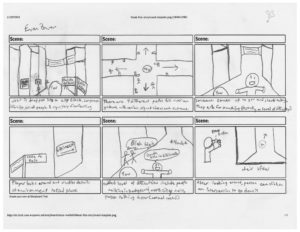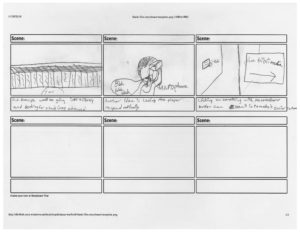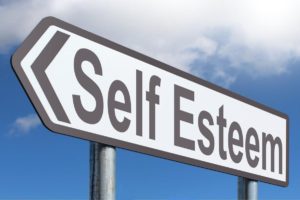Introduction
The idea behind the proposed virtual reality experience, “Language Immersion”, is to expose students to different parts of the world, and different languages. Students commonly take classes to learn languages, and practice specific words and concepts during class time. A big part of language is how it is used casually with the slang and colloquialisms used within a native speakers daily life. These colloquialisms might not be learned in a classroom setting, because no native speakers may be present. Language Immersion can help students immerse themselves into the natural environment of a language, and learn how it is spoken naturally, and formally. A study was done with the game “Second Life” to see if anonymous online learning would be more helpful in language learning, than a classroom environment. The data did show that it was helpful, and some students appreciated their interactions with native speakers in a way that was casual and without the penalty of failure (Melchor-Couto). Exploring a foreign area with an unfamiliar language is not only educational, but fun.
The target audience for this product are students, and or other individuals that are trying to learn a foreign language. While Language Immersion can be used for personal use, the main idea is to use Language Immersion to increase a students understanding in a language that they are learning, and not solely be taught words, and sentences. While classroom-based learning has the possibility of a student forgetting what was learned by the end of class, Language Immersion will draw its audience in with its simple design; in the foreign environment a student or individual is exposed to, accomplishing daily tasks, and using different methods than traditional classroom and textbook learning, can help them make the leap in learning their desired language.
Learning Objectives and Outcomes
- The user will learn foreign languages by being immersed into a foreign environment
- The user will learn foreign languages by being immersed in environments where the language is spoken fluently
- The user will be exposed to a variety of foreign language scenarios and be able to listen and learn
- Uses difficulty levels to introduce a number of different concepts related to language
- The user should learn a language in a more casual and practical sense
Language Immersion is educational, because it simulates real world experiences for someone who is learning a new language. Many people learn languages quicker and more effectively when they are immersed in an experience. According to the Center for Advanced Research on Language Acquisition, “research finds that immersion students whose first language is not English become more balanced bilinguals and develop higher levels of bilingualism” (carla.unm.edu). If these students are required to use the foreign language, they will be more likely to learn it. Other language applications fail, because they are not practical, or realistic. They are often too structured, and do not allow a user to truly be exposed to a language. These applications teach you how the language works on paper, but are unable to show and immerse a user into an environment surrounding a desired language, failing to accurately teach slang or casual conversation. This is an area that VR immersion excels in. By total immersion into a language, and into an environment that is real and accurate, users will be allowed to feel as if they were away from home, and their native language.
Progress can be assessed by using data that is gathered from the users of the Language Immersion experience. This data can tell us vital information, such as, if a user is passing levels, and increasing their knowledge and fluidity in a certain language. In addition, when applied to a classroom setting, teachers can evaluate the students’ progress before and after using the experience for the time of use, based on the curriculum. For example, a written knowledge base line test could be administered prior to using the Language Immersion VR App, and then after continued use for a week or more, a second test can be administered. This experience can be developed to fit a number of flexible curriculum’s and time frames, but just for an example, a week is appropriate. Scores and results can be shared between institutions, teachers, and the application developer in order to further understand how language learning is being affected by the immersion of VR. A beneficial data collection can also be conducted in the applications early development stages, to test if people are learning from it. This would be similar to focus groups and/or play tests. By utilizing focus groups and play tests, certain aspects of production or development could be revisited, in order to release a more complete application.
User Experience / User Interface
Language Immersion will be usable through Google Cardboard, Galaxy Gear and any of the more advanced virtual reality set ups. Our goal is to reach maximum accessibility, so that it can reach a bigger audience. In it’s simple design, this application will not have too many choices that might overwhelm the audience. An example of this simplicity are the first, four choices presented, including different roads. In the use of the Google Cardboard, each choice can be selected by using the small button on the top of the cardboard. The layout of Language Immersion is similar to a point and click adventurer, but instead of exploring a picture, a user is exploring a 3D immersive virtual space. The first level will take place on a city block, with signs in the foreign language, and people will be walking around. Someone will walk up to the user and ask for directions to a specific place, tasking the user with leading them there. The success of that task will depend on the ability of the user to understand that language, even with background noise and other conversations occurring around them. The best place to film this virtual experience is on a city block in the United States, and build it on actual clues that exist in that area to orient people; this will look very similar to Google Street View.
Implementing would be speaking responses, instead of just pointing and clicking, will be the next step in Language Immersion. In the example of the task of giving directions, to direct the person, a user would have to use their words to guide them to a certain location. The difficulty to implement voice in Language Immersion is unknown, but it would be a massive step not only for the application, but teaching, as well. A similar example of this technology is the built-in microphone in the Duolingo Mobile app, that allows users to speak into the app to answer questions, and prove that they can pronounce each word correctly.
Implementation Strategy
Our teams goal is to market Language Immersion to teachers and schools, as a supplement to language classes. A great way to market this application would be to attend various teaching conventions, and set up demos to try to appeal to this demographic. One conference our team would market at would be the Modern Language Association (MLA) Convention which is held yearly, and in 2018, had an attendance of 6,040 teachers and scholars (Modern Language Association). The MLA convention is an appropriate place to demo at, because there are many language educators that would be interested in the product. Another convention is the American Council on the Teaching of Foreign Languages annual convention, hosted by an organization of more than 12500 language educators and administrators (ACTFL).
Also, Language Immersion will be marketed to regular consumers to use, if they want to learn a language on their own, like Duolingo. It would be downloadable as an app, and used with Google Cardboard, which is fairly accessible. Advertising through Instagram, Reddit and Twitter would be the most successful way, because it needs to appeal to a more tech savvy audience. Additionally, we could send our application to various tech savvy or education-minded internet personalities to test and sponsor our product, if they are interested. Some possible personalities would be the Vlogbrothers, two brothers who cover various topics, but find an interest in talking about education, with 3.1 million subscribers on YouTube, VSauce, a science YouTube brand with 13 Million subscribers on the main channel, and Austin McConnell, an eclectic YouTuber with almost 730,000 subscribers, who covers content such as books, film, weird trivia, and obscure history.
Long Term Vision
The initial prototype is being kept simple, because at this time, our goal is the quality of the application, not how much it can do. In keeping our project focused, we have limited the paths to four, and a few interactions will occur based on a users actions in the application. In a series of applications to come in the next five years, there will be free roam mode, voice interactions, stories, and more chapters. In free roam mode, users will have conversations with people in environments that they find, by either wondering, or picking a location to travel to. With the experience of free roam mode, a user can be even more immersed, because there is no script behind the actions they take.
Voice interactions in and out of free roam mode, will enable a user to talk to the people in the experience, instead of clicking the VR headset. This will make interactions more interesting for the user, including in, hospitals, restaurants, and other areas, not just cities. As the levels increase, the application will memorize who the user meets, and increase the complexity of the conversations based on the difficulty level, including more slang and casual conversation.
Secondary audiences could be immigrants who want to come to the United States, as they often use the world and media around them to learn the language of the country that they move to. This application can help people learn English before they migrate, for it would immerse them into the environment of a specific area they are moving to. The next phase of development will be releasing more languages, and more locations, based on the popularity of languages. Not only would students benefit from the educational value of knowing a second language, but those who are learning for work, and or personal purposes will benefit, also.
Works Cited
Melchor-Couto, Sabela. “Virtual World Anonymity and Foreign Language Oral Interaction.” ReCALL, vol. 30, no. 02, 2018, pp. 232–249., doi:10.1017/s0958344017000398.
Shelley, Mary Wollstonecraft, and Susan J. Wolfson. Mary Wollstonecraft Shelleys Frankenstein, or, The Modern Prometheus. Pearson Longman, 2007.
Increasing Student Engagement and Retention Using Mobile Applications : Sma…: Books, Articles and More. https://eds.a.ebscohost.com/eds/detail/detail?vid=3&sid=8958ac06-1457-4297-9d39-ea5bcfcb4864%40sessionmgr4008&bdata=JnNpdGU9ZWRzLWxpdmUmc2NvcGU9c2l0ZQ%3d%3d#AN=513323&db=nlebk. Accessed 29 Nov. 2018.
Evaluation of Distance Education Applications in the Kyrgyz Republic Univer…: Books, Articles and More. https://eds.a.ebscohost.com/eds/detail/detail?vid=2&sid=8958ac06-1457-4297-9d39-ea5bcfcb4864%40sessionmgr4008&bdata=JnNpdGU9ZWRzLWxpdmUmc2NvcGU9c2l0ZQ%3d%3d#AN=124997730&db=eue. Accessed 29 Nov. 2018.
Essa Ahmed, Heba Bahjet. “Duolingo as a Bilingual Learning App: a Case Study.” Arab World English Journal, Vol. 7 no. 2, June 2016, pp. 255-267, https://ezproxy.stevenson.edu/login?url=https://search.ebscohost.com/login.aspx?direct=true&db=eue&AN=116912698&site=eds-live&scope=site
DeWaard, Lisa. “Is Rosetta Stone a Viable Option for Second-Language Learning?” ADFL Bulletin, vol. 42, no. 2, 2013, pp. 61-72, https://ezproxy.stevenson.edu/login?url=https://search.ebscohost.com/login.aspx?direct=true&db=mzh&AN=2013651579&site=ehost-live
MLA Convention Statistics. Modern Language Association. https://www.mla.org/Convention/Convention-History/MLA-Convention-Statistics. Accessed Dec. 5, 2018.
About the American Council on the Teaching of Foreign Languages. American Council on the Teaching of Foreign Languages. https://www.actfl.org/about-the-american-council-the-teaching-foreign-languages. Accessed Dec. 5, 2018.
Byerly, Alison. “Are We There Yet? Virtual Travel and Victorian Realism. U of Michigan P, 2012, https://ezproxy.stevenson.edu/login?url=https://search.ebscohost.com/login.aspx?direct=true&db=mzh&AN=2014306920&site=ehost-live
N.A. Aziz et al. “Modelling and optimisation of upgradability in the design of multiple life cycle products: a critical review.” Journal of Cleaner Production, Vol. 112 Part 1, January 2016, pp. 282-290, https://www.sciencedirect.com/science/article/pii/S0959652615011671
Stephen J. Cowley, Rasmus Gahrn-Andersen. “Simplexity, languages and human languaging.” Language Sciences, Vol. 71, January 2019, pp. 4-7, https://www.sciencedirect.com/science/article/pii/S0388000118301360
Presentation Link: https://docs.google.com/presentation/d/1sK9t91oMNtJiWm7QoUBWPPOXs-QWbtuPvfbCTqdaLwY/edit?usp=sharing




